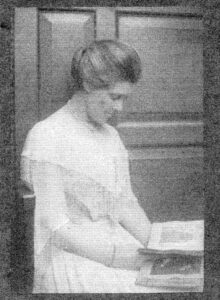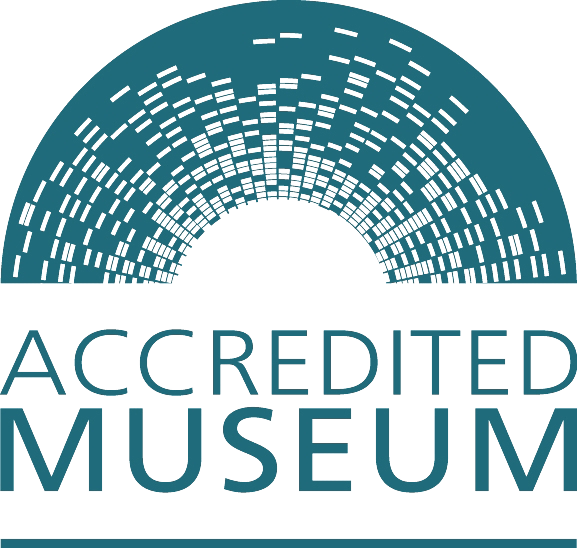
By Penny Nuttall
Since 1971 and the seminal article on women and art by Linda Nochlin [Why have there been no great women artists? ARTnews Jan 1971] women artists have slowly emerged from the shadows; rediscovered in history and embraced in the present. From Artemisia Gentileschi through Mary Cassatt to Tracey Emin, the complexity of women and art either as subjects from the male gaze or as women artists and their role in the arts has been examined on all sides.
So how did women in C.R. Ashbee’s Guild of Handicraft fit in? Did they work as Guild members or ancillary workers, what arts and crafts were they skilled in and did the Guild attract other women artists to the north Cotswolds community? In Guild photographs men are shown at work whilst women were generally shown in the plays that Ashbee produced in the summers although there is one of a cooking lesson – all women. So in the norms of the time men worked, women adorned, at least on the surface. Ashbee himself was not a feminist even openly mocking one of his sisters Elsa who was an active suffragette. [1] His focus was on the brotherhood of men whose origins lay in the Gothic Revival and Pre-Raphaelite Brotherhood founded earlier in the nineteenth century. This male bonding mirrored the social practises of the time. [2] Such inequality in places of work as well as very formal social conventions between men and women, made Ashbee’s Guild a difficult place for craftswomen to take their part in this male gathering. [3]

So, starting the search in the small library at Court Barn, I looked for any named women who had worked at Chipping Campden’s Guild of Handicraft. I found in Ashbee’s own book on the Guild in Campden [4] a full list of working members and a list of those that worked for the Guild but not members. Amongst these non-members were three women; Annie (Anastasia) Power, Lottie Eatley and Nellie (or Mollie or Millie) Binning – all noted as bookbinders. In these lists, names are mostly by initials and surnames (for the men) but for these three women their names are written in full. The only other woman who was active within the Guild (though not a member) was Janet, Ashbee’s wife, doing day to day administration of the Essex House Press as well as editor and co-author of some of the books produced.

Lottie and Nellie have been hard to trace so far, their names are often derivative of other names and thus making connections in censuses difficult. But their backgrounds may have been more working class than Annie Power’s was, Lottie was the wife or daughter of Richard Eatley and Nellie is either a daughter or wife of Thomas Binning (this needs more research to determine which). Both Richard and Thomas were printers with the Kelmscott Press who came with the printing presses after these were bought for the Essex House Press. Annie Power has been easier to find in records – her father Henry Power was a well-known ophthalmic surgeon, a lecturer on human anatomy, physiology, as well as an artist. There is enough information on Annie for another article so I will leave her story for the present. But for Lottie and Nellie the search continues.

Several women artists and craftswomen were attracted to the Guild and Chipping Campden, including Ethel Mary Partridge/Coomaraswamy /Mairet (hand loom weaver and dyer) and Margaret Calkin James (graphics, calligraphy, textile printing, watercolour painting, stage design and printmaking). Also, Florence Kingsford an illustrator whose occasional work for the Guild is to be found decorating some of the Essex House Press publications. And some trained/apprenticed men like Alec Miller apprenticed by Miss C. P. Anstruther (later Mrs Mackay). I hope to compile a list of women who directly or indirectly had some contact with the Guild in Chipping Campden. Some may remain only a name with their skill, but in naming these individuals they will at least become visible again.
Here in Court Barn, we celebrate one woman within the work of nine individuals. She is Katherine Adams (1862-1952) a bookbinder, who moved to Broadway in 1901 when her father became Vicar of Weston-sub-Edge. In childhood she was playmates with Jenny and May Morris, daughters of William Morris. Largely a self-taught bookbinder she briefly trained in bookbinding with Sarah Prideaux and T J Cobden-Sanderson in 1897. This was followed by the setting up of two workshops, one in Lechlade and then the Eadburgha Bindery in Gloucestershire where she trained and employed 2 assistants, both women. She was president of the Women’s Guild of Arts in 1893 (established by May Morris) whilst becoming a fellow of the Royal Society of Arts in 1938. Her works are to be found in the British Library and private collections as well as here within Court Barn.
[1] Women in the Arts and Crafts movement: 1870-1914, A. Callen
[2] op cit.
[3] op cit.
[4] C.R. Ashbee, Craftsmanship in Competitive Industry, 1908
You may also be interested in Inspirational Women behind the Guild, Herstory Janet Ashbee
+44 (0)1386 841951
admin@courtbarn.org.uk



October – March
Tuesday – Sunday 10am – 4pm
April – September
Tuesday – Sunday 10am – 5pm